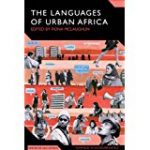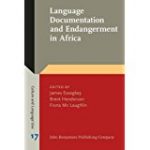Books
2015. Language documentation and endangerment in Africa. James Essegbey, Brent Henderson & Fiona Mc Laughlin, eds. Amsterdam: John Benjamins. My chapter: “Can a language endanger itself? Reshaping repertoires in urban Senegal” (131-151)
2009. The languages of urban Africa. Fiona Mc Laughlin, ed. London: Continuum. My chapters: “Introduction to the languages of urban Africa” (1-18); “Senegal’s early cities and the making of an urban language” (71-85)
2009. Selected Proceedings of the 38th Annual Conference on African Linguistics. Masangu Matondo, Fiona Mc Laughlin & Eric Potsdam, eds. Waltham: Cascadilla Press. Also available online at www.lingref.com/cpp/acal/38/index.html
2006. Murambi, the Book of Bones. An English translation of Murambi, le livre des ossements, a novel by Boubacar Boris Diop, with an introduction. Bloomington: Indiana University Press. [7th printing, new edition 2016]
Selected articles & chapters
IN PRESS. With Karim Ouaras. “Extreme linguistic landscapes.” In Robert Blackwood & Stefania Tufi, eds. Handbook of Linguistic Landscapes. London: Bloomsbury.
IN PRESS. “The pew inscriptions at First African Baptist Church in Savannah, Georgia.” In Nicholas Faraclas, Anne Storch and Viveka Velupillai, eds. Hospitable linguistics: Alternative, indigenous and critical approaches to language and language research. London: Bloomsbury.
IN PRESS. “Atlantic consonant mutation.” In The Oxford Guide to the Atlantic Languages, Friederike Lüpke, ed. Oxford UP.
IN PRESS. “Ajami writing practices in Atlantic-speaking Africa.” In The Oxford Guide to the Atlantic Languages, Friederike Lüpke, ed. Oxford UP.
2023. “Text as city: Dakar’s linguistic landscape.” In Deborah Pellow & Suzanne Scheld, eds. Africa and Urban Anthropology: Theoretical and Methodological Contributions from Contemporary Fieldwork. Routledge.
2023. “Postscript on gendered dichotomies in African youth language and language practices.” In Taiwo Oloruntoba-Oju, ed. Gendered dichotomies in African youth language and language practices. Stuttgart: ibidem Press. 241-245.
2022. “Urban Wolof then and now.” In Paul Kerswill & Heike Wiese, eds. Urban contact dialects and language change: Insights from the global North and South. Routledge (Studies in Language Change).
2021. “The linguistic ecology of the Sahel.” In Leonardo A. Villalón, ed. The Oxford Handbook of the African Sahel. Oxford University Press.
2018. “How a lingua franca spreads.” In Tracing language movement in Africa. Ericka Albaugh & Kathryn M. de Luna, eds. Oxford University Press. 213-233.
2017. “The social meanings of Wolof and French: Contact dialects, language ideology, and competing modernities in Senegal.” In Dialect and Identity Performance, Reem Bassiouney, ed. Routledge. 179-191.
2017. (With Caroline Wiltshire) “Syllable weight in the phonology of Pulaar.” In Syllable Weight in African Languages, Paul Newman, ed. John Benjamins. 161-176.
2015.” Linguistic warscapes of northern Mali.” Linguistic Landscape 1(3):213-242.
2015.” Inflection in Pulaar” In The Oxford Handbook of Inflection, Matthew Baerman,ed. Oxford UP. 419-445.
2014. “Senegalese digital repertoires in superdiversity: A case study from Seneweb.” Discourse, Context and Media 4-5:29-3
2012. “Religious authority and Wolof discourse on clandestine migration to the Canary Islands.” In Religion et migration. Eric Ross, Fatima Harrak & Souad Anegay, eds. Rabat: Institut des Études Africaines, Université Mohammed V- Souissi. 235-249.
2011. “Youssou N’Dour’s Sant Yàlla/Egypt: A musical experiment in Sufi modernity.” Popular Music 30(1):71-87.2011.
2011. (With Leonardo A. Villalon.) “Mettre en scene la légitimité: analyse d’un discours de feu Xalifa Abdoul Aziz Sy et de son jottalikat.” In Communication wolof et société sénégalaise. Sascha Kesseler, Anna Diagne, & Christian Meyer, eds. Paris: L’Harmattan. 323-344.
2010. (With Babacar Mboup.) “Mediation and the performance of religious authority in Senegal.” Islamic Africa 1(1):39-61.
2008. “On the origins of urban Wolof: evidence from Louis Descemet’s 1864 phrase book.” Language in Society 37(5):713-735.
2008. “The ascent of Wolof as an urban vernacular and national lingua franca.” In Globalization and language vitality: Perspectives from Africa. Cécile B. Vigouroux & Salikoko S. Mufwene, eds. London: Continuum. 142-170.
2008. “Senegal: the emergence of a national lingua franca.” In Language and national identity in Africa. Andrew Simpson, ed. Oxford: Oxford University Press. 79-97.
2005. “Voiceless Implosives in Seereer-Siin. ” Journal of the International Phonetic Association 35(2):201-214.
2005. “Reduplication and consonant mutation in the Northern Atlantic languages.” In Studies on reduplication. Bernhard Hurch, ed. Berlin: Mouton de Gruyter. 111-133.
2004. “Is there an adjective class in Wolof?” In Adjective classes: A cross-linguistic typology.” R.M.W. Dixon and Alexandra Y. Aikhenvald, eds.Oxford: Oxford University Press. 242-262.
2001. (With Thierno Seydou Sall.) “The give and take of fieldwork: noun classes and other concerns in Fatick, Senegal.” Linguistic fieldwork. Paul Newman and Martha Ratliff, eds. Cambridge University Press. 189-210.
- “Dakar Wolof and the configuration of an urban identity.” Journal of African Cultural Studies 14(2):153-172.
- “Consonant mutation and reduplication in Seereer-Siin.” Phonology 17(3):333-363.
2000. “‘In the name of God I will sing again, Mawdo Malik the good’: Popular music and the Senegalese Sufi tariqas.” Journal of Religion in Africa 30(2):191-207.
- “Noun classification in Wolof: When affixes are not renewed.” Studies in African Linguistics 26(1):1-28.
1997. “Islam and popular music in Senegal: The emergence of a ‘new tradition.’” Africa 67(4):560-581. (Journal of the International African Institute, London).
- “Haalpulaar identity as a response to Wolofization.” African Languages and Cultures 8(2):153-168.
- “Consonant mutation in Seereer-Siin.” Studies in African Linguistics 23(3):279-313.


